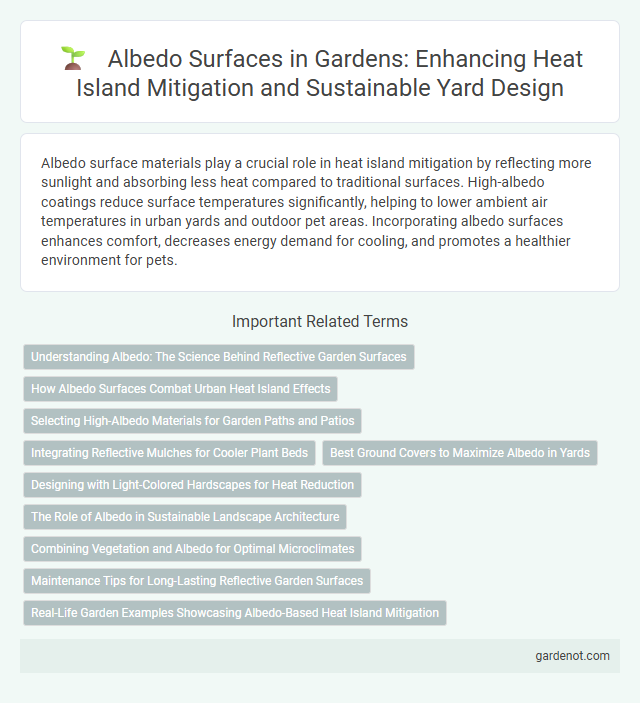Albedo surface materials play a crucial role in heat island mitigation by reflecting more sunlight and absorbing less heat compared to traditional surfaces. High-albedo coatings reduce surface temperatures significantly, helping to lower ambient air temperatures in urban yards and outdoor pet areas. Incorporating albedo surfaces enhances comfort, decreases energy demand for cooling, and promotes a healthier environment for pets.
Understanding Albedo: The Science Behind Reflective Garden Surfaces
Albedo refers to the measure of a surface's reflectivity, indicating how much solar radiation is reflected back into the atmosphere rather than absorbed as heat. High albedo surfaces, such as reflective garden materials, reduce urban heat island effects by minimizing heat retention in outdoor spaces. In heat island mitigation yards, selecting plants and surfaces with a high albedo coefficient significantly lowers surface temperatures and contributes to improved thermal comfort.
How Albedo Surfaces Combat Urban Heat Island Effects
Albedo surfaces combat urban heat island effects by reflecting a higher percentage of solar radiation, reducing surface temperatures and lowering ambient heat in urban areas. These surfaces, often made from light-colored materials or reflective coatings, prevent heat absorption that contributes to excessive warming. Implementing high-albedo materials on rooftops, pavements, and roadways significantly mitigates heat accumulation, enhancing urban thermal comfort and decreasing energy demand for cooling.
Selecting High-Albedo Materials for Garden Paths and Patios
Selecting high-albedo materials for garden paths and patios significantly reduces heat absorption, lowering surface temperatures in urban heat island mitigation yards. Reflective surfaces such as light-colored concrete, white gravel, and pale stone enhance solar reflectance, increasing albedo and minimizing heat buildup. Utilizing these materials improves outdoor thermal comfort while contributing to energy savings by decreasing the ambient temperature around homes and public spaces.
Integrating Reflective Mulches for Cooler Plant Beds
Reflective mulches with high albedo surfaces significantly reduce soil temperatures by reflecting solar radiation, thereby mitigating heat island effects in yard environments. Integrating these materials into plant beds enhances cooling by minimizing heat absorption and promoting healthier plant growth. Their use complements other heat reduction strategies, contributing to overall temperature regulation and urban sustainability.
Best Ground Covers to Maximize Albedo in Yards
High-albedo ground covers such as white gravel, light-colored concrete, and reflective pavers significantly enhance yard albedo by reflecting more solar radiation and reducing heat absorption. Drought-tolerant plants with silvery or gray foliage, like lamb's ear and artemisia, boost surface reflectivity while minimizing water use. Incorporating these materials maximizes heat island mitigation by lowering surface temperatures and improving overall yard climate resilience.
Designing with Light-Colored Hardscapes for Heat Reduction
Designing with light-colored hardscapes, such as concrete or pavers with high albedo surfaces, significantly reduces heat absorption by reflecting more sunlight and minimizing heat island effects. These materials lower surface temperatures, enhancing outdoor comfort and decreasing cooling energy demand in urban environments. Implementing light-colored albedo surfaces is a proven strategy for effective heat island mitigation in residential and commercial yards.
The Role of Albedo in Sustainable Landscape Architecture
Albedo surfaces significantly enhance sustainable landscape architecture by increasing the reflectivity of outdoor areas, thereby reducing heat absorption and lowering surface temperatures. High-albedo materials, such as light-colored pavements and reflective coatings, minimize urban heat island effects and improve microclimate comfort. Incorporating albedo optimization in landscape design supports energy efficiency and promotes thermal comfort in densely built environments.
Combining Vegetation and Albedo for Optimal Microclimates
Combining high-albedo surfaces with dense vegetation significantly reduces urban heat island effects by reflecting solar radiation and enhancing evapotranspiration. This synergy creates cooler microclimates, improving thermal comfort and air quality in yard environments. Implementing albedo-enhanced pavements alongside strategically placed green cover optimizes temperature regulation and energy efficiency.
Maintenance Tips for Long-Lasting Reflective Garden Surfaces
Regular cleaning of albedo surfaces removes dirt and debris that reduce reflectivity, ensuring maximum heat island mitigation. Applying a protective sealant every 12-18 months preserves surface integrity against UV degradation and weathering. Inspecting for cracks or damage periodically allows prompt repairs, maintaining high albedo performance and extending the lifespan of reflective garden surfaces.
Real-Life Garden Examples Showcasing Albedo-Based Heat Island Mitigation
Real-life garden examples showcasing albedo-based heat island mitigation demonstrate how reflective surfaces like white gravel, light-colored mulch, and pale stone pathways significantly reduce ambient temperatures by reflecting solar radiation. Studies reveal gardens with high-albedo materials can lower surface temperatures by up to 10degF, thereby improving urban microclimates and reducing cooling energy demand. Incorporating albedo surfaces in landscaping promotes greener, cooler urban environments while preserving plant health and enhancing outdoor comfort.
Albedo surface Infographic

 gardenot.com
gardenot.com